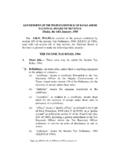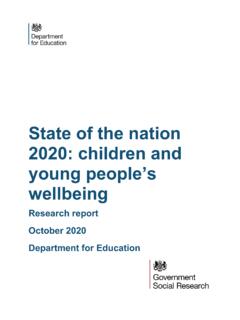Transcription of Children & Young People’s Mental Health in the Digital Age
1 Children & Young people sMental Health in the Digital AgeShaping the FutureChildren & Young people s Mental Health in the Digital Age Shaping the FutureContentsWhat the evidence says 4 Recommendations 10 References 14 Almost half of the world is connected to the internet, and in countries that are members of the OECD almost everyone is online (Echazarra, 2018[1]). For chil-dren and Young people today, being online and using social media have become an integral part of their lives.
2 In 2015, a typical 15-year-old from a country that is a member of the OECD had been using the internet since age 10 and spent more than two hours every weekday online after school, and more than three hours on a weekend day (OECD, 2017[2]). This reliance on Digital technology has fuelled concerns from parents, teachers, gov-ernments and Young people themselves that Digital technologies and social media are exacerbating feelings of anxiety and depression, disturbing sleep patterns, leading to cyber-bullying and distorting body image. In response to these and other concerns, some countries are taking action.
3 Legislation prevents Korean Children from playing online games that require a resident registration number between midnight and 6am without parental permission; while the Government of the United Kingdom is reviewing how so-cial media affect Children s wellbeing, as well as how much screen time is the mass availability and use of Digital technologies is a relatively recent phenomenon, there is limited hard evidence available to date on whether Digital technologies, including social media, cause Mental Health problems in Children and Young people . But associa-tions do exist between internet use and Mental wellbeing.
4 It appears a little bit of inter-net use can have a small positive impact on Children and Young people s wellbeing, while the two extremes of not being online at all and excessive use can have a small negative impact on Mental wellbeing (UNICEF, 2017[3]). Similarly, while not proving causation, excessive use of Digital technologies and social media are associated with Mental illness (McCrae, Gettings and Purssell, 2017[4]) (Vannucci, Flannery and Ohannessian, 2017[5]). Greater social media use is associated with poorer sleep, with a significant link found between playing video games in the evening and sleep deprivation (Billari, Giuntella and Stella, 2018[6]).
5 Digital platforms also provide tools for cyber-bullying with evidence of a rise in cyber-bullying in some countries (Livingstone, Stoilova and Kelly, 2016[7]). Social media is also associated with body image concerns (Fardouly and Vartanian, 2016[8]) and disordered eating (Holland and Tiggemann, 2016[9]).As the rapid take-up of Digital technologies and social media by Children and Young people continues, it is crucial to adopt an approach that minimises the risks without restricting the considerable opportunities and benefits Digital technologies and social media have to offer.
6 Children , Young people , and their families should be empowered to be responsible online participants and educated about appropriate Digital use and risks. Industry should be encouraged to produce relevant, appropriate and accessible content and tools. It remains critical that Children and Young people who display signs of Mental illness get help OECD is uniquely placed to help countries address Children and Young people s men-tal Health challenges in the Digital age. OECD s expertise includes benchmarking Mental Health performance across member countries and measuring outcomes reported by those experiencing Mental Health disorders via the Patient-Reported Indicators Survey (PaRIS) initiative.
7 The OECD s triennial Programme for International Student Assessment (PISA)survey assesses 15-year-old school student performance worldwide and collects valuable information on student attitudes and motivations. Deep Digital expertise and under-standing of technological innovation and its uses is reflected in the OECD s Going Digital Children & Young people 's Mental Health in the Digital AgeWHAT THE EVIDENCE SAYSWhat the Evidence SaysWith half of Mental illness1 beginning by age 14 it is critical to intervene early to minimise its effects on development, education, employment and healthHalf of all Mental illnesses begin by the age of 14 and three-quarters by mid-20s (Kessler et al.)
8 , 2007[10]), with anxiety and personal-ity disorders sometimes beginning around age 11 (OECD, 2012[11]). Mental Health problems repre-sent the largest burden of disease among Young people , and Mental ill- Health is at least as preva-lent among Young people as among adults (OECD, 2015[12]). A survey across 10 countries found around one-quarter of Young people had a Mental disorder (OECD, 2012[11]) many as 10% of boys and 14% of girls aged 11 reported feeling low more than once a week in the last six months on average across 28 Europe-an countries which are members of the OECD.
9 The share of Children reporting feeling low increases quite sharply with age, and gender differences become even starker as 11-year-olds, 14% of girls compared to 10% of boys felt low, but as 15-year-olds, this gap widened with 29% of girls feeling low compared with only 13% of boys. Rates were highest in Italy across all age groups, although this may reflect a different cultural understanding and interpretation of this question of 'feeling low'. The greatest difference between those aged 11 and 15 was found in Ireland, the United Kingdom, Swe-den, Greece and Italy (World Health Organization, 2016[13]).
10 1 In this paper " Mental illness" refers to any condition that meets clinical diagnosis threshold criteria. The term Mental illness is used interchangeably with Mental ill- Health , Mental disorders and Mental Health problems . The absence of Mental wellbeing or poor Mental wellbeing, can affect all individuals from time to time, and may not meet the clinical threshold of a Mental Health This includes affective, neurotic, personality, devel-opment, behavioural, eating and sleeping disorders, as well as schizophrenia and substance abuse. Shaping the Future OECD2018 5 WHAT THE EVIDENCE SAYSWhen the first onset of a Mental disorder occurs, usually in childhood or adolescence, these disorders tend to be moderate rather than severe (OECD, 2012[11]).
















